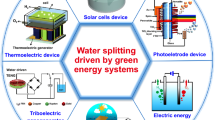Abstract
The problem of water management in a fuel cell with a polymer electrolyte membrane (PEM) under low humidity conditions is most acute. The addition of adsorbents to a membrane improves the water-holding properties of PEMs. A stationary one-dimensional computer model is developed to analyze the distribution of water in the layers of membrane electrode assembly. An ionomer layer modified with an adsorbent is taken into account to increase the concentration of water in the membrane. The spatial distribution of the concentration of water in the catalytic layer and PEM for a standard membrane and a membrane containing a surface modified layer is obtained. The best distribution of water in the membrane is achieved through the addition of a layer with a threefold increase in water capacity from the side adjacent to a cathode catalytic layer.




Similar content being viewed by others
REFERENCES
G. Gebel, Polymer 41, 5829 (2000). https://doi.org/10.1016/S0032-3861(99)00770-3
N. H. Jalani, K. Dunn, and R. Datta, Electrochim. Acta 51, 553 (2005). https://doi.org/10.1016/j.electacta.2005.05.016
V. di Noto, S. Lavina, E. Negro, et al., Electrochim. Acta 53, 1618 (2007). https://doi.org/10.1016/j.jpowsour.2008.10.066
W. K. Chao, C. M. Lee, D. C. Tsai, et al., J. Power Sources 185, 136 (2008). https://doi.org/10.1016/j.jpowsour.2008.06.052
M. S. Kang, Y. J. Choi, H. J. Lee, and S. H. Moon, J. Colloid Interface Sci. 273, 523 (2004). https://doi.org/10.1016/j.jcis.2004.01.050
F. Chen, B. Mecheri, A. d’Epifanio, et al., Fuel Cells 10, 790 (2010). https://doi.org/10.1002/fuce.200900179
E. Chalkova, M. V. Fedkin, D. J. Wesolowski, and S. N. Lvov, J. Electrochem. Soc. 152, A1035 (2005). https://doi.org/10.1149/1.1895225
H. Tamura, A. Tanaka, K. Y. Mita, and R. Furuichi, J. Colloid Interface Sci. 209, 225 (1999). https://doi.org/10.1006/jcis.1998.5877
N. H. Jalani, K. Dunn, and R. Datta, Electrochim. Acta 51, 553 (2005). https://doi.org/10.1016/j.electacta.2005.05.016
K. T. Adjemian, R. Dominey, L. Krishnan, et al., Chem. Mater. 18, 2238 (2006). https://doi.org/10.1021/cm051781b
J. Li, G. Xu, X. Luo, et al., Appl. Energy 213, 408 (2018). https://doi.org/10.1016/j.apenergy.2018.01.052
Y. J. Kim, W. C. Choi, S. I. Woo, and W. H. Hong, J. Membrane Sci. 238, 213 (2004). https://doi.org/10.1016/j.memsci.2004.04.005
E. Y. Safronova and A. B. Yaroslavtsev, Solid State Ionics 221, 6 (2012). https://doi.org/10.1016/j.ssi.2012.05.030
G. Alberti, M. Casciola, D. Capitani, et al., Electrochim. Acta 52, 8125 (2007). https://doi.org/10.1016/j.electacta.2007.07.019
M. Casciola, D. Capitani, A. Comite, et al., Fuel Cells 8, 217 (2008). https://doi.org/10.1002/fuce.200800005
I. Nicotera, L. Coppola, C. O. Rossi, et al., J. Phys. Chem. B 113, 13935 (2009). https://doi.org/10.1021/jp904691g
R. Vetter and J. O. Schumacher, Comput. Phys. Commun. 234, 223 (2019). https://doi.org/10.1016/j.cpc.2018.07.023
Y. P. Ying, S. K. Kamarudin, and M. S. Masdar, Int. J. Hydrogen Energy 43, 16068 (2018). https://doi.org/10.1016/j.ijhydene.2018.06.171
A. B. Yaroslavtsev, Y. A. Karavanova, and E. Y. Safro-nova, Pet. Chem. 51, 473 (2011). https://doi.org/10.1134/S0965544111070140
C. Yin, L. Wang, J. Li, et al., Phys. Chem. Chem. Phys. 19, 15953 (2017). https://doi.org/10.1039/C7CP03052E
G. Vasu, A. K. Tangirala, B. Viswanathan, and K. S. Dhathathreyan, Int. J. Hydrogen Energy 33, 4640 (2008). https://doi.org/10.1016/j.ijhydene.2008.05.051
I. Nicotera, T. Zhang, A. Bocarsly, and S. Greenbaum, J. Electrochem. Soc. 154, B466 (2007). https://doi.org/10.1149/1.2712833
C. C. Ke, X. J. Li, Q. Shen, et al., Int. J. Hydrogen Energy 36, 3606 (2011). https://doi.org/10.1016/j.ijhydene.2010.12.030
Funding
This work was financially supported by the Russian Ministry of Science and Higher Education (project no. RFMEFI60419X0243).
Author information
Authors and Affiliations
Corresponding author
Additional information
Translated by A. Tulyabaev
Rights and permissions
About this article
Cite this article
Mensharapov, R.M., Fateev, V.N. The Membranes with Modified Surface to Stabilize Water Balance of Fuel Cell under Low Humidity Conditions: A Model Study. Nanotechnol Russia 15, 363–369 (2020). https://doi.org/10.1134/S1995078020030088
Received:
Revised:
Accepted:
Published:
Issue Date:
DOI: https://doi.org/10.1134/S1995078020030088




